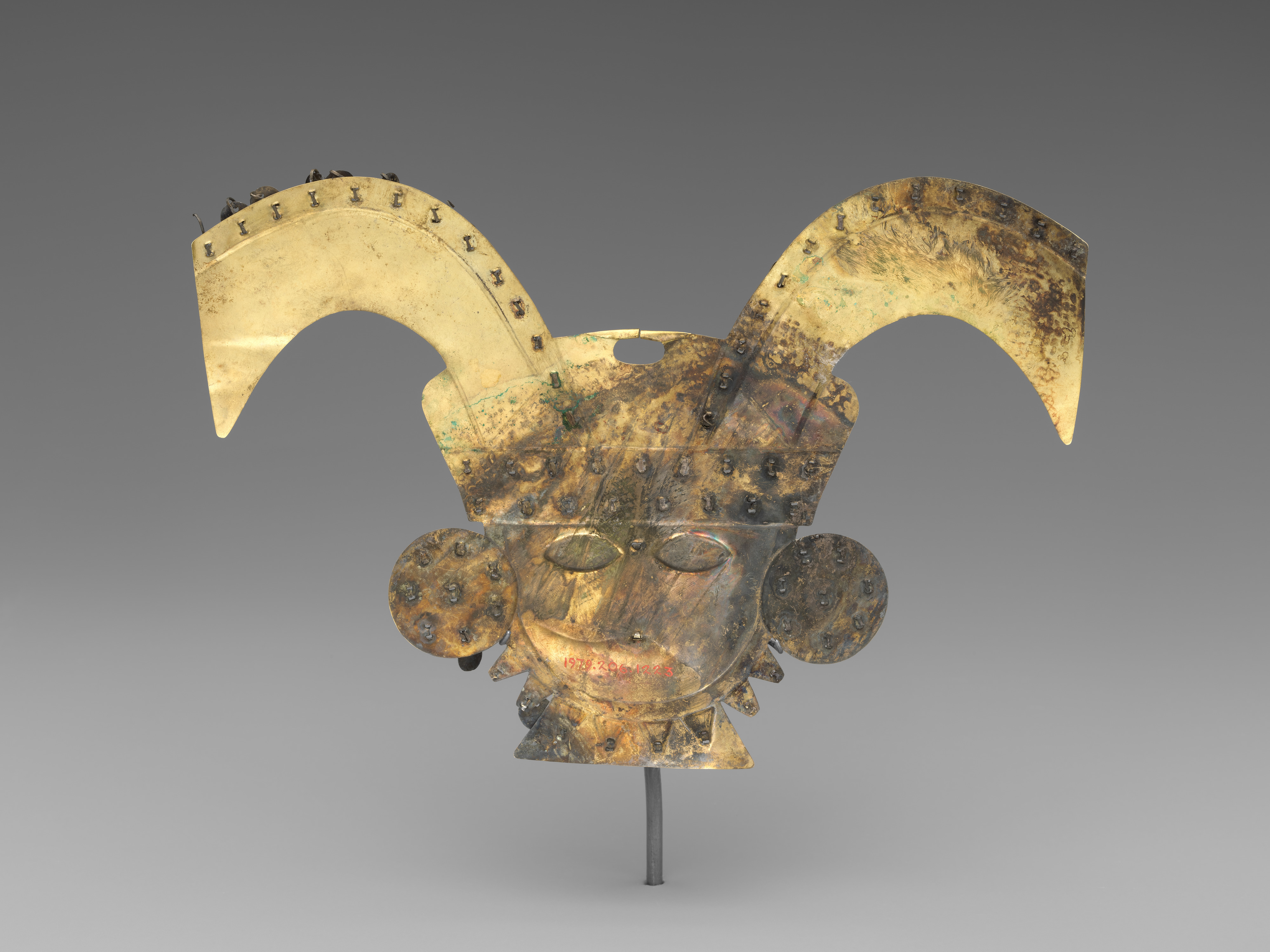Nose Ornament, Turbaned Head
Not on view
This resplendent nose ornament depicts an individual wearing a crescent-shaped nose ornament, large earspools, and a turbaned headdress with projecting plumes, fastened under the chin with a patterned textile band. The object was cut from a piece of gold sheet and the design was worked from both sides. The chinstrap, ear and nose ornaments, headband and upper region of each plume were subsequently silvered. The nose, rendered in high relief, was produced from a separate sheet of gold and was attached to the face by tabs. In addition, dangles were originally affixed throughout the silvered regions, although now only a few survive—on the headdress and ear spools. The eyes were probably once inlaid with white shell; turquoise or a dark stone likely would have been added to represent the pupils. In its original state, the contrast between the gold and the silver—including the shimmering dangles—and the bright eyes must have created a striking display of beauty and power.
The Moche (also known as the Mochicas) flourished on Peru’s North Coast from 200-850 A.D., centuries before the rise of the Incas. Over the course of some six centuries, the Moche built thriving regional centers from the Nepeña River Valley in the south to perhaps as far north as the Piura River, near the modern border with Ecuador, developing coastal deserts into rich farmlands and drawing upon the abundant maritime resources of the Pacific Ocean’s Humboldt Current. Although the Moche never formed a single centralized political entity, they shared unifying cultural traits such as religious practices (Donnan, 2010).
It has long been assumed that images of Moche figures wearing elaborate regalia—such as the headdress, nose ornament, and earspools shown on the present object—depicted high-ranking males, likely warriors. Recent archaeological discoveries, however, have shown that at times certain females were adorned with nose ornaments and laid to rest with ceremonial weapons (Franco Jordán 2011; Mujica Barreda, 2007). Furthermore, female ritual specialists have been identified both archaeologically and in fineline paintings on Moche ceramics (Castillo, 2002; Donnan and Castillo, 1992; Donnan and McClelland 1999:131). One of the characteristic accoutrements of these priestesses is a pair of bilateral headdress flares or plumes, similar to those depicted here. Given this new evidence, we must allow for the possibility that this work might have been worn by a woman, and may well also represent a woman.
This object was said to have been found at the burial site of Loma Negra, which was one of the most northern outposts of Moche culture. Loma Negra works in metal share similar iconography with ceramics and metalwork found at Moche sites father to the south, such as Ucupe (Bourget, 2014). The precise relationship between the Loma Negra and the Moche “heartland” remains a subject of debate, however (Kaulicke, 2006).
References and Further Reading
Bourget, Steve. Les rois mochica: Divinité et pouvoir dans le Pérou ancien. Paris: Somogy éditions d'art; Geneva: MEG, Musée d'ethnographie de Genève, 2014.
Castillo, Luis Jaime. “Las señoras de San José de Moro: Rituales funerarios de mujeres de élite en la costa norte del Perú.” Arkeos: Revista Electrónica de Arqueología PUCP 1, no. 3 (2002), pp. 1-10.
Disselhoff, Hans-Dietrich. “Metallschmuck aus der Loma Negra, Vicus (Nord-Peru).” Antike Welt vol. 3 (1972), pp. 43–53.
Donnan, Christopher B., and Luis Jaime Castillo. “Finding the Tomb of a Moche Priestess.” Archaeology 45, no. 6 (1992), pp. 38-42.
Donnan, Christopher B. “Moche State Religion.” In New Perspectives on Moche Political Organization, edited by Jeffrey Quilter and Luis Jaime Castillo, pp. 47-69. Washington D.C.: Dumbarton Oaks Research Library and Collection.
Donnan, Christopher B. and Donna McClelland. Moche Fineline Painting: Its Evolution and its Artists. Los Angeles: UCLA Fowler Museum of Cultural History, 1999.
Franco Jordán, Régulo. “La Dama de Cao,” Investigación y ciencia 417 (2011), pp. 68-74.
Jones, Julie. “Mochica Works of Art in Metal: A Review.” In Pre-Columbian Metallurgy of South America, edited by Elizabeth P. Benson, pp. 53-104. Washington, DC: Dumbarton Oaks Research Library and Collection, 1979.
Jones, Julie, and Heidi King. “Gold of the Americas.” The Bulletin of the Metropolitan Museum of Art vol. 59, no. 4 (Spring 2002), p. 19.
Kaulicke, Peter. “The Vicús-Mochica Relationship.” In Andean Archaeology III, edited by William H. Isbell and Helene H. Silverman, pp. 85-111. Boston, MA: Springer, 2006.
King, Heidi, Luis Jaime Castillo Butters, and Paloma Carcedo de Mufarech. Rain of the Moon: Silver in Ancient Peru. New York, New Haven and London: The Metropolitan Museum of Art, 2000, p. 31.
Lechtman, Heather, Antonieta Erling, and Edward J. Barry Jr. “New Perspectives on Moche Metallurgy; Techniques of Gilding Copper at Loma Negra, Northern Peru.” American Antiquity vol. 47 (1982), pp. 3-30.
Mujica Barreda, Elías, Régulo Franco Jordán, César Gálvez Mora, Jeffrey Quilter, Antonio Murga, Carmen Gamarra, Victor Ríos, Segundo Lozada Alcade, John Verano, and Marco Aveggio, El Brujo: Huaca Cao, centro ceremonial Moche en el Valle de Chicama. Lima: AFP Integra, 2007.
Pillsbury, Joanne, Timothy Potts, and Kim N. Richter. Golden Kingdoms: Luxury Arts in the Ancient Americas, edited by Los Angeles: J. Paul Getty Museum, 2017.
Schorsch, Deborah. "Silver-and-Gold Moche Artifacts from Loma Negra, Peru." Metropolitan Museum Journal vol. 33 (1998), pp. 109-136.
Schorsch, Deborah, Ellen G. Howe, and Mark T. Wypyski, “Silvered and Gilded Copper Metalwork from Loma Negra: Manufacture and Aesthetics.” Boletín Museo del Oro vol.4 (1996), pp. 145-163.
Due to rights restrictions, this image cannot be enlarged, viewed at full screen, or downloaded.
This artwork is meant to be viewed from right to left. Scroll left to view more.



